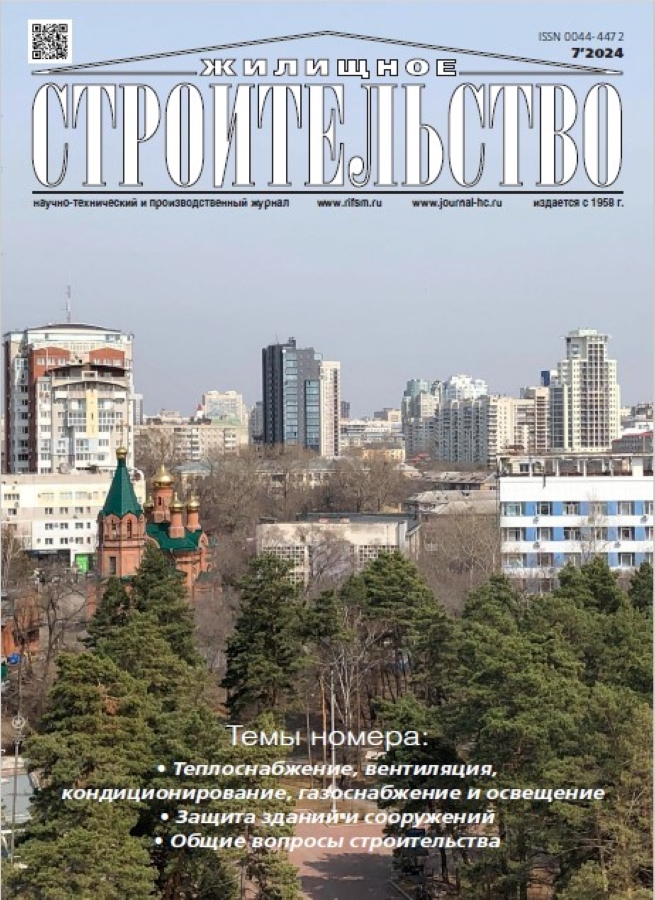Experimental studies of heat gain into building premises through wooden building envelopes in summer
- Authors: Levin E.V.1, Okunev A.Y.1
-
Affiliations:
- Scientific-Research Institute of Building Physics of RAACS
- Issue: No 7 (2024)
- Pages: 38-45
- Section: Articles
- URL: https://ruspoj.com/0044-4472/article/view/634805
- DOI: https://doi.org/10.31659/0044-4472-2024-7-38-45
- ID: 634805
Cite item
Abstract
Experimental studies were carried out to measure heat input into the premises of buildings with wooden envelops in the summer. Two types of wooden building envelopes were studied: solid wood (log frame) and a wall insulated with mineral wool based on a wooden frame with a ventilated facade made of metal siding. The structures differ in thermal inertia and the magnitude of thermal resistance. As a result of the research, it was established that in the summer, for a solid wood constraction, the maximums and minimums of the heat flux density into the room are shifted relative to the maximums and minimums of temperature fluctuations on the external surface for a time of about 6.5 hours. Maximum heating of the room occurs in the evening around 9–10 pm. The minimum air temperature is reached around 9–10 am. For a frame wall, the shift in the maximum and minimum heat flux density is about 2 hours, which is due to the much lower thermal inertia of such a structure. The measured daily fluctuations in inner air temperature are at the level of 2оС, while for a room with a solid wood wall can reach 5оС, which is associated with the higher heat-insulating properties of the frame wall. The characteristic values of the density of heat flows entering the premises were: 2.0 W/m2 for a solid wood wall and -0.2 W/m2 for a frame wall.
Full Text
About the authors
E. V. Levin
Scientific-Research Institute of Building Physics of RAACS
Author for correspondence.
Email: aqwsrv@list.ru
Candidate of Science (Physics and Mathematics)
Russian Federation, 21, Lokomotivniy Driveway, Moscow, 127238A. Y. Okunev
Scientific-Research Institute of Building Physics of RAACS
Email: okunevay@gmail.com
Candidate of Science (Physics and Mathematics)
Russian Federation, 21, Lokomotivniy Driveway, Moscow, 127238References
- Czvetkov D.N. Thermal engineering justification for building envelopes made of laminated wood energy-efficient assortments. Vestnik of the Tomsk State National University of Architecture and Civil Engineering. 2012. No. 2, pp. 81–90. (In Russian).
- Akel’ev V.D., Voronova N.P., Kostevich M.F. Thermal conditions in heated rooms at a given change in outside air temperature. Energetika. Proceedings of higher education institutions and power engineering associations. 2014. No. 2, pp. 79–85. (In Russian).
- Rafal’skaya T.A., Mansurov R.Sh., Raginskaya A.O., Rasenko D.A. Thermal resistance of building envelopes and the thermal regime of premises during periods of cutting off the temperature schedule. Izvestiya vuzov. Investicii. Stroitel’stvo. Nedvizhimost’. 2017. Vol. 7. No. 4, pp. 192–203. (In Russian).
- Rymarov A.G., Lushin K.I. Features of calculating the thermal regime of a building with massive enclosing structures during the cold season. Stroitel’stvo: nauka i obrazovanie. 2012 . No. 2, pp. 1–6. (In Russian).
- Lahcene Bellahcene, Ali Cheknane, SMA. Bekkouche, and Djemal Sahel. The effect of the thermal inertia on the thermal transfer in building wall. E3S Web of Conferences. 2017. No. 22, 00013. DOI: https://doi.org/10.1051/E3SCONF/20172200013
- Zakharevich A.E. The influence of daily fluctuations in outside temperature on the indoor microclimate. Nauka i texnika. 2016. Vol. 15. No. 6, pp. 476–480. (In Russian).
- AL-Sanea S.A., Zedan M.F. Improving thermal performance of building walls by optimizing insulation layer distribution and thickness for same thermal mass. Applied Energy. 2012. № 88 (9), pp. 3113–3124.
- Kestutis Valancius, Alfonsas Kazys Skrinska, Sabina Paulauskaitė. Investigation of unsteady heat transfer process in an one-cell building. Journal of Civil Engineering and Management. 2006. Vol. XII. No. 1, pp. 97–101.
- Hodder S., Parsons K. The effects of solar radiation on thermal comfort. International Journal of Biometeorology. 2007. No. 51, pp. 233–250.
- Hodder S., Parsons K. The effects of solar radiation and black body re-radiation on thermal comfort. Ergonomics. 2008. No. 51 (4), pp. 476–491.
- Sereda S.N. The influence of insolation on the indoor microclimate. Mezhdunarodny nauchno-issledovatel’skiy zhurnal. 2021 No. 5 (107). Part 1, pp. 93–98. (In Russian). DOI: https://doi.org/10.23670/IRJ.2021.107.5.015
- Levin E.V., Okunev A.Y. Taking into account the non-stationarity of heat transfer during thermal engineering inspections of enclosing structures. Zhilishchnoe Stroitel’stvo [Housing Construction]. 2021. No. 7, pp. 19–29. (In Russian). DOI: https://doi.org/10.31659/0044-4472-2021-7-19-29
Supplementary files













